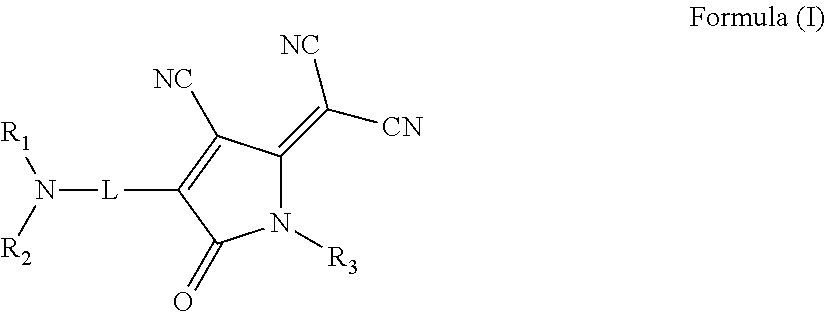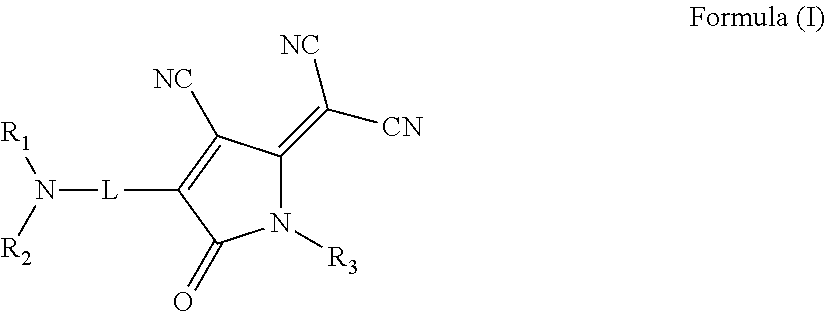Nonlinear optical materials and nonlinear optical device using the same
a nonlinear optical and material technology, applied in the direction of optical elements, polarising elements, instruments, etc., can solve the problems of deterioration of nonlinear optical properties of materials, difficult production of large organic crystals needed for devices, and brittleness of organic crystals
- Summary
- Abstract
- Description
- Claims
- Application Information
AI Technical Summary
Benefits of technology
Problems solved by technology
Method used
Image
Examples
synthesis example 1
Synthesis of Exemplary Compound (1)
[0258]Exemplary Compound (1) was synthesized according to the following scheme.
[0259]—Synthesis of Intermediate (A)—
[0260]350 ml of ethanol was added to 15.5 g (0.12 mol) of 2-amino-1,1,3-tricyano-1-propene and 27.3 g (0.24 mol) of ethyl pyruvate, and heated to reflux for 1 hour under nitrogen flow. After cooling, solution of 15.3 g (0.094 mol) of 4-acetamide benzaldehyde dissolved in 50 ml of 2-methoxyethanol was added to the reaction solution, and heated to reflux for 2 hours under nitrogen flow. After cooling to room temperature, the precipitated crystals were separated by filtration to yield 16.2 g (52% yield) of an intermediate (A).
[0261]—Synthesis of Intermediate (B)—
[0262]350 ml of ethanol was added to 15.0 g (0.046 mol) of the resulting intermediate (A), and heated to reflux, and 15 ml of the concentrated sulfuric acid was carefully added dropwise to the solution. Until the intermediate (A) was consumed, the concentrated sulfuric acid was a...
synthesis example 2
Preparation of Exemplary Compound (2)
[0269]Exemplary Compound (2) was synthesized according to the following scheme.
[0270]0.15 g (0.2 mmol) of Exemplary Compound (1), 0.092 g (0.35 mmol) of triphenylphosphine and 0.1 ml (1.1 mmol) of 1-butanol were dissolved in 4 ml of tetrahydrofuran, and 0.17 ml (0.37 mmol) of diethyl azodicarboxylate (2.2 mol / l toluene solution) was added dropwise under nitrogen flow condition and under ice-cooling. The reactants were warmed to room temperature and stirred for 5 hours, and the solvent was distilled off under reduced pressure. The resulting solid was washed with ethanol, and the crystals were separated by filtration. The obtained crystals were purified by silica gel column chromatography (chloroform) to yield Exemplary Compound (2). The quantity was 1.12 g, and the yield was 74%.
[0271]1H NMR (CDCl3) δ 8.50 (d, 1H), 7.92 (d, 2H), 7.90 (d, 2H), 7.79 (d, 2H), 7.28 (d, 1H), 6.91 (d, 2H), 4.34 (t, 4H), 4.19 (t, 2H), 3.77 (t, 4H), 2.27 (m, 2H), 1.39-1.7...
synthesis example 3
Preparation of Exemplary Compound (51)
[0273]Synthesis was performed, it was synthesized in the same manner in the synthesis of Exemplary Compound (1), except that N,N-bis(2-hydroxyethyl)-3-methoxyaniline was used instead of N-phenyethanolamine. N,N-bis(2-hydroxyethyl)-3-methoxyaniline was synthesized with reference to the method described in “Bio-Organic and Medicinal Chemistry Letters (Bioorg. Med. Chem. Lett)”, 21, (2011), pp. 940-943.
PUM
 Login to View More
Login to View More Abstract
Description
Claims
Application Information
 Login to View More
Login to View More - R&D
- Intellectual Property
- Life Sciences
- Materials
- Tech Scout
- Unparalleled Data Quality
- Higher Quality Content
- 60% Fewer Hallucinations
Browse by: Latest US Patents, China's latest patents, Technical Efficacy Thesaurus, Application Domain, Technology Topic, Popular Technical Reports.
© 2025 PatSnap. All rights reserved.Legal|Privacy policy|Modern Slavery Act Transparency Statement|Sitemap|About US| Contact US: help@patsnap.com



